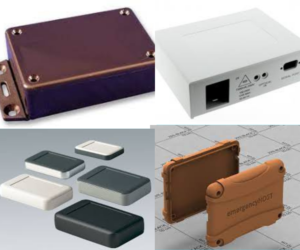How to Become a Data Scientist in 2022
An Introduction to Enclosures - Volume I
An Introduction to Enclosures - Volume I
Whether you’re an electrical installer, design engineer or an OEM, the chances are that you deal with electrical enclosures on a day-to-day basis. While on the face of it the humble enclosure may seem to be one of the simplest components to specify, in reality the variety of choice available on the market may mean that the most obvious solution isn’t always the best in terms of reliability and long-term profitability.
To many end-users an enclosure is simply a box in which to store electrical components or connections, and the specification process needs to take no more time than is required to decide on the right size. (Click here for information Enclosures Design and Engineering) However, if you look at the range of options on the market it becomes apparent that there are many more variables to take into consideration.
Enclosures are surrounding case constructed to provide a degree of protection to personnel against incidental contact with the enclosed equipment and to provide a degree of protection to the enclosed equipment against specified environmental conditions. Enclosures are usually made from rigid plastics or such metals as steel, stainless steel, or aluminum.
(Click here to know how Enclosures are Designed and Developed)
With our technology growing at such a fast pace, innovative enclosures are more important than ever. Choosing the right type of enclosure can save not only lives, but billions in equipment and operating costs. (Know more about Enclosures Categories available) Enclosures are available in many different materials, shapes and sizes and all of them are relevant to different sectors of the market. The suitability of each enclosure depends on the application that it will be used for. The electronic enclosure is one of the most critical components in electronic circuits, as it does not only house the entire module but also protects it from damages and circuit failures caused due to various environmental factors. Thereby, it is becoming of utmost importance to select appropriate electronic cabinets or an electronic enclosure according to the project specifications to mitigate the risks of downtime and operational hindrances. Important factors to keep in mind while selecting an appropriate electronic cabinet.
- Engineering Application and IP Ratings
The design of electronic cabinets may change according to the electronic specifications of your circuit and its engineering applications. Furthermore, the requirements about Ingress Protection ratings (IP ratings) also reflect a crucial factor in the selection process as they precisely address the needs vis-à-vis the degree of protection against contact with live parts, damage control against mechanical impact, and other mechanical factors such as the opening of water along with other solid foreign components.
- Environmental Conditions
It is important to understand what operating environment and weather conditions the circuit will be exposed to, in order to make the appropriate choice of an electronic enclosure. Having clarity about where the enclosure is going to reside is necessary, especially for choosing the right material. Based on whether the enclosure will be walled in indoor areas, outdoors, exposed to harsh heat conditions or chemical contaminants or in extreme weather conditions, the material and other specifications of an electronics enclosure can be derived. (Click here to check kinds of Heat Sink Enclosures)
- Thermal Requirements
Thermal conditions and specifications of the electronic circuit must be taken into consideration while choosing cabinets for sensitive electrical components. This is another important aspect that makes a significant impact on the choice of material for electronic enclosures. Plastics are excellent insulators, which can be used in enclosures for electronic circuits with low heat dissipation needs. However, for circuits with high voltage and high current specifications, which may potentially reflect in significantly high power density heat dissipation, metallic enclosures may prove more suitable.
- Industry Standards related to Design and Performance
Governing bodies, international standard committees such as International Electro-Technical Commission (IEC) and as well as government policymakers and regulators have defined and developed industry standards for electrical, electronic and related technologies. (Click here to know complete procedure on Product Development and technologies used) These identify specifications of a product that must be conformed with, and they must be taken into consideration while choosing the right electronic enclosure.
- Types of Materials
Recent advancements in material sciences and technologies have increased the availability of various types of materials to suit the exact need for electronic enclosures in different applications. Apart from the thermal, electrical, and environmental requirements, other factors that may influence the choice of materials in electronic cabinets are price, size, weight, and aesthetics. Acrylic is one of the most cost-efficient window materials. Acrylic is one of the popular choices of materials, as it is lightweight, flexible, lightweight, and mainly due to its greater impact resistance qualities over the glass.
- Total Cost of Ownership
Understanding the value of cabinets, which mainly depends on the purchasing cost along with operating and maintenance costs, is important while making the right choice of electronic enclosures. An appropriate enclosure can be selected by taking into consideration the maintenance and downtime costs that may incur in different varieties, which ultimately have an impact on the TCO.
- Size of the Equipment
This is one of the most basic yet important factors that must be thought of while choosing an appropriate enclosure. Though smaller sizes of enclosures are preferred in modern electronic equipment, the depth of the final product must be considered while choosing a cabinet to make the process of installation more convenient and feasible. Furthermore, the electronic enclosure should also be big enough to enable proper power distribution and cable management in the circuit.
- Flexibility of Design
Based on the design of the circuit, the enclosure should offer enough flexibility in terms of depth, height, and width. Also, with the advent of advanced technologies such as Information Technology (IT), Big Data, and the Internet of Things (IoT), the enclosure should be flexible enough to integrate various controls for routers and other IT equipment.
- Electromagnetic Compatibility
With the increasing incorporation of advanced technologies and modern electronic appliances becoming faster than ever, the problem of electromagnetic interference (EMI) has become a prominent concern. With the issue of EMI becoming more prevalent, an enclosure that can offer EMI protection must be chosen in cases where the equipment is used in environments with the presence of EMI.
- Scope for Future Modifications
It is probably the most important factor that needs to be considered while making a choice of an electronic enclosure. Think about the potential for modification and cutouts for various reasons such as for adding a weather control to the roof, creating space for Human-Machine Interface (HMI), or adding a cable entry, when selecting a cabinet for your equipment.
Types of Enclosures
1. Custom Electronic Enclosures:
These custom electronic housings are designed in all sorts of shapes and styles to fit our customer’s needs. Some of the electronic enclosures are single PCB enclosures and some are electronic housings with numerous electronic components housed and secured within the plastic enclosure.
2. Standard Electronic Enclosures:
Standard enclosures are well-known for the secure packaging of electronic components. Their applications range from agricultural technology to mechanical engineering to security technology.
3. Battery Enclosures:
Battery enclosures keep your batteries safe from weather and safe from theft. Battery enclosure boxes also feature locking mechanisms that protect unauthorized people against possible electrical dangers if they happen to be tampering with your equipment.
4. IP Rated Enclosure:
ABS is a two-phase polymer blend that provides good all-round performance for electronic enclosures. For that reason, ABS is used in most cases in the OKW range. It is best suited for use in enclosed rooms but is less suitable for outdoor use. (Need something tougher? Specify Polycarbonate instead.
Blending ASA with PC boosts performance at high temperatures and also increases the impact strength. Combining these plastics also provides good resistance against chemicals and weather.
5. Die Cast Aluminum Enclosures:
Die-cast aluminium housings are also lightweight, but they offer more compression strength and rigidity than plastic. Typically, die-cast aluminium enclosures are used to house electronic, pneumatic, hydraulic and electrical devices. They are especially good for housing sensitive electronic assemblies because of the EMI shielding and heat dissipating quality of aluminium.
6. Heat sink Enclosures
Heat sink enclosures role is to creating a larger surface area on a heat-producing device, and in doing so, allowing for a more efficient transfer of heat out and into its surroundings. An improved thermal path out of the device lowers any temperature rise at the junction of the component.
7. Metal Enclosures
If your box will be located outside, a metal enclosure will protect it from rain, snow, sleet, and extreme weather fluctuations. Plastic, on the other hand, expands when exposed to harsh conditions. While metal does cost more than plastic, it is longer lasting and more durable.
8. 3D Printed Enclosures
The main reason to have a 3D printer enclosure is to reduce warping of some materials upon extrusion. An enclosure will keep the temperature in the vicinity of the print bed more homogeneous, protecting the area from drafts, but also from dust. It also adds a safety layer to your printer, reduces noise, and helps organize space.
9. Acrylic Enclosures
Strong, stiff, clear plastic available in a variety of brilliant colours, Acrylic is a transparent plastic material with outstanding strength, stiffness, and optical clarity. Acrylic sheet is easy to fabricate, bonds well with adhesives and solvents, and is easy to thermoform. It has superior weathering properties compared to many other transparent plastics. Acrylic sheet exhibits glass-like qualities clarity, brilliance, and transparency but at half the weight and many times the impact resistance of glass.
10. Cabinet Enclosures
A cabinet enclosure is a cabinet for electrical or electronic equipment to mount switches, knobs and displays and to prevent electrical shock to equipment users and protect the contents from the environment. The enclosure is the only part of the equipment which is seen by users.
Recently Published
Popular Newsletters
Most Viewed
How to Write and Publish an Academic Research
Various domains for final year project of an
ENGINEERING PROJECT IDEAS FOR FINAL YEAR STUDENTS Engineering
SELECTING THE RIGHT PROJECT FOR FINAL YEAR Selecting
AIR QUALITY MONITORING SYSTEM BASED ON IOT USING
Trending
Contact us for complete guide
Address List
- # 28, 1st Main Road,1st Cross, Shakthi Garden, Kalyan Nagara, Bengaluru-72
- +91-968-696-3065
- eng@pincore.in














